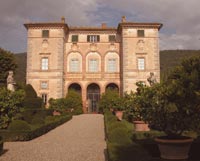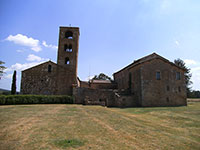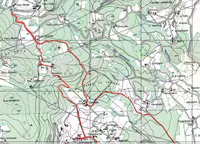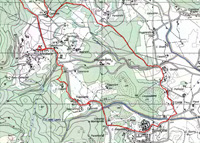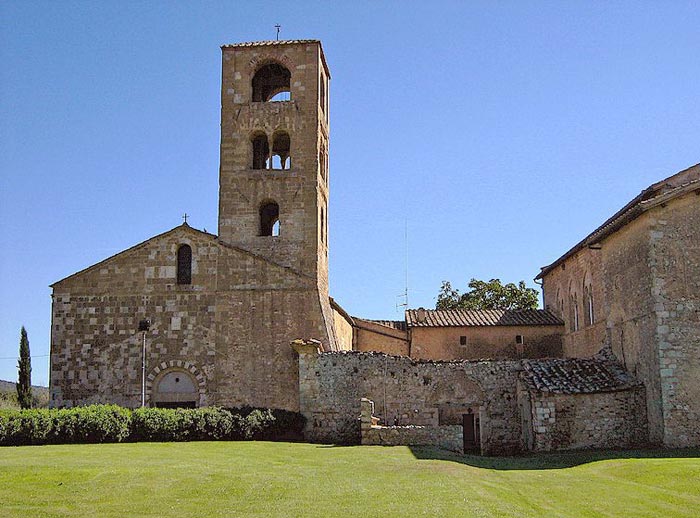 |
Sovicille, Pieve di San Giovanni Battista a Ponte allo Spino
|
La montagnola senese |
La montagnola senese extends in the districts of Siena, Monteriggioni, Sovicille and Casole d'Elsa, but for the most part it is located in the district of Sovicille. The area Architecture and landscape
|
||||
Ampugnano - village that rises near the airport. The buildings still have their ancient medieval structure; a charming small church, the well in the main square and the one behind the church remind the visitor of the old way of living. Ancaiano - this place was already inhabited in the first period of the Bronze Age. The existing church is dedicated to San Bartolomeo and it was built in Renaissance-style in 1660, thanks to Pope Alessandro VII Chigi. The church is aisless, it is on the plan of a Latin cross and at the end there is an apse with projecting transept. Capraia - the castle of Capraia stands upon a craggy hill. The Ardengheschi Family had this castle built in order to protect their estate, when Siena had their previous castle of Orgia destroyed. Rumors said that it was impregnable because of its three boundary walls and because it stands upon a rocky hill. In 1100-1250 the Republic of Siena and the Ardengheschi Family contended this castle, then several owners succeded, till the last noble family that arrived here on the 24th September 1554; all the Family members were slain together with all the inhabitants of the village by the Marquis of Marignano's troops. The Marquis had an agreement with the Medici Family, according to which he had besieged Siena, that was nearly surrendering. Nowadays it is possible to see the tower that has been recently restored by the current owners. |
||||
| Castello di Celsa is an old castle, converted to a palatial villa in the sixteenth century and with a garden built in the seventeenth century. Castello di Celsa, owned by the princely Aldobrandini family, lies fourteen kilometers south-east of Siena. The first informations about the castle date back to the 1st August 1344. The Celsi Family, who owned the castle, had it rebuilt in order to transform it in a villa according to Baldassarre Peruzzi's plans, who also conceived the gardens. Castello di Celsa was renovated in the 19th century, at which time the crenelated appearance it has today was created. It features a fine parterre garden in front of the villa, a walled hunting park, and a 'parco inglese'. Today it is a private residence. |
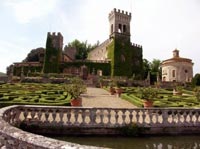 |
|||
| Villa Centiale is a 16th century villa in the Ancaiano district near Siena, Italy. Designed by the architect Carlo Fontana, the villa was built in the 1600s by Cardinal Flavio Chigi for Pope Alexander VII — Fabio Chigi. The gardens at Villa Cetinale are renowned as being amongst the most beautiful in Italy. The estate features sculpture by Mazzuoli. Villa Cetinale was originally a farmhouse built over an ancient Etruscan settlement. It was renovated under the guidance of Carlo Fontana, a pupil of Bernini, in 1676. Fontana designed the stairs at the rear of the house. Above the villa there is a hermitage, called the Romitorio, a five storey hermitage inhabited by monks until the end of XIX century, now fully restored.. To get to this hermitage, one must climb a sacred path called scala santa (holy stairs), which is about 300 steps. The Blessed Chigi had this building built in 1716 in order to give hospitality to the Coenobite monks, who took care of ill people. The straight line that runs from the Romitorio down the avenue and past the house finishes on the southeastern side of the villa, with an enormous statue of Hercules, also by Mazzuoli. Garden visits are Monday to Friday 9.30 – 12.30 by appointment only. Gardens in Tuscany | Villa Cetinale |
||||
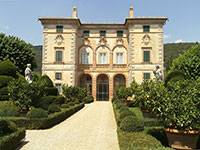 |
 |
 |
||
| Villa Cetinale, Sovicille | Parco Villa Cetinale
|
Romitorio di Cetinale
|
||
Malignano - Some documents written before the year 1000 mention the castle of Malignano. There is an oratory dedicated to the Archangel Michael; in this place the Ardengheschis and the Republic of Siena subscribed some agreements. In 1259 the village was burnt and destroyed by the Florentine troops. |
||||
| Molli - the first documents about the parish church date back to 1078; on 2nd February the countess Matilde of Canossa gave the Bishop of Volterra this church as a donation, however, according to some researches into the walls, it could have been built during the Longobard period or the Frankish one. It is a church with nave and two aisles; the altar has been rebuilt, probably by using the stones of the bell-tower destroyed by a lightning in 1930. The front has a symmetrical structure and has been probably rebuilt in the first years of the XVIII century.
Montarrenti - the charming castle stands upon a craggy hill (345 m. / 1132 ft. high); the first informations about the castle date back to 1156. Palazzaccio - ancient fortified building of the Republic of Siena. In 1333 the village was burnt by the troops of Pisa; it is still possible to see the damages, as the building has never been cleaned nor rebuilt. Palazzo al Piano - it has Medieval origins and stands at a height of about 430 m. / 1416 ft.
|
 |
|||
| Montarrenti - the charming castle stands upon a craggy hill (345 m. / 1132 ft. high); the first informations about the castle date back to 1156.
Palazzaccio - ancient fortified building of the Republic of Siena. In 1333 the village was burnt by the troops of Pisa; it is still possible to see the damages, as the building has never been cleaned nor rebuilt. Palazzo al Piano - it has Medieval origins and stands at a height of about 430 m. / 1416 ft.
|
||||
| Pernina - the old parish church of Santa Maria in Pernina stands at a height of about 499 m. / 1637 ft.; it dates back to the XII century. The bell-tower, on a square plan, is about 22 m. / 72,4 ft. in height and it stands in front of the church.
Personata - this small deconsecrated church, dedicated to Santa Margherita, has ancient origins, probably Etruscan origins, but the first informations date back to the XIII century. The Parish Church of San Giovanni Battista, better known as the Pieve di ponte allo Spino, rises in the center of Rosia. The most archaic element is the Lombard-influenced bell tower that displays a succession of single, double, triple, and four-light windows placed in four orders. It has an elegant fagade with limestone ashlars, with three steps leading to a door, surmounted by a round arch and three single-light windows. A 14th-century, prism-shaped baptismal font is found inside, with the Baptism of Christ depicted on the front of it, as well as a 15th-century Madonna Enthroned with Child and Saints Sebastian and Anthony the Abbot by Guidoccio Cozzarelli. |
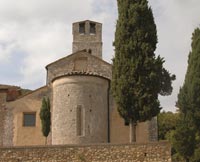 Pieve di Pernina Pieve di Pernina |
|||
| The Pieve di ponte allo Spino already existed in 1050 and it was a halting-place along the road that linked the "Via Cassia" to the "Via Aurelia". Under the courtyard some precious mosaics of the Roman Empire Age have been found; they were part of a large Roman villa. The entrance of the church is interesting, as you have to go down some steps to enter the church. It consists of a building with nave and two aisles and it was built in late Romanesque French style, that is quite similar to the Gothic style. The capitals are gracefully decorated with human figures and geometrical ornaments. |
|
|||
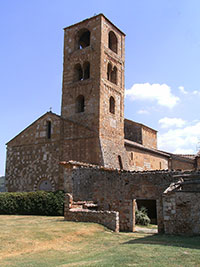 |
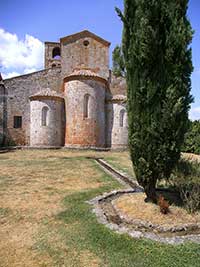 |
 |
||
| Sovicille, Pieve di San Giovanni Battista a Ponte allo Spino | Pieve di San Giovanni Battista a Ponte allo Spino, absidi
|
Pieve di Ponte allo Spino, resti dell'antico chiostro, colonnetta romana | ||
| Ponte della Pia - (Pia's Bridge) it is the most charming bridge of this area. In Etruscan times an ancient road crossed it; the bridge linked the Merse Valley to the Maremma Toscana. The bridge has probably Roman origins and it has been rebuilt during the Middle Ages in Romanic style. According to some legends, the beautiful Pia, Nello d'Inghiramo de' Pannocchieschi's sorrowful wife, crossed this bridge to go into exile in Maremma, at Castello della Pietra. Dante Alighieri, too, wrote about this legend (Divine Commedy, "Purgatorio", Canto V).
|
 |
|||
| San Giusto a Balli - the first informations about this parish church date back to 994; it originally had a nave and two aisles, but nowadays there are just two aisles, because of an intense intervention made in the XV century. The beautiful church well dates back to the XII-XIII century; it was built by using semicircular limestone blocks. |
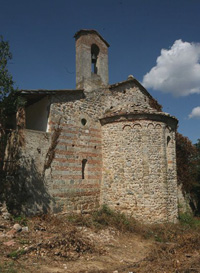 La pieve di San Giusto a Balli
|
|||
| Simignano - it stands at a height of about 410 m. / 1345 ft. along the road that goes from Ancaiano to Pievescola; it has uncertain origins, but it probably dates back to the Roman Age. The first informations date back to 1163, when it was subdued by Siena. The beautiful, small church is dedicated to San Magno and it has a wonderful bell-tower, which is simple but graceful.
Torri - small Medieval village, where the Abbey of Santa Mustiola is, which was built in the XII century and has a wonderful cloister. The small villages of Tonni, Toiano, Tegoia and Abbadia Isola are really charming: they have stayed as they were, and here time seems to have stopped.
|
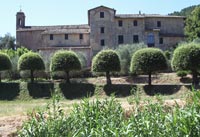 Pieve di Santa Mustiola in Torri |
|||
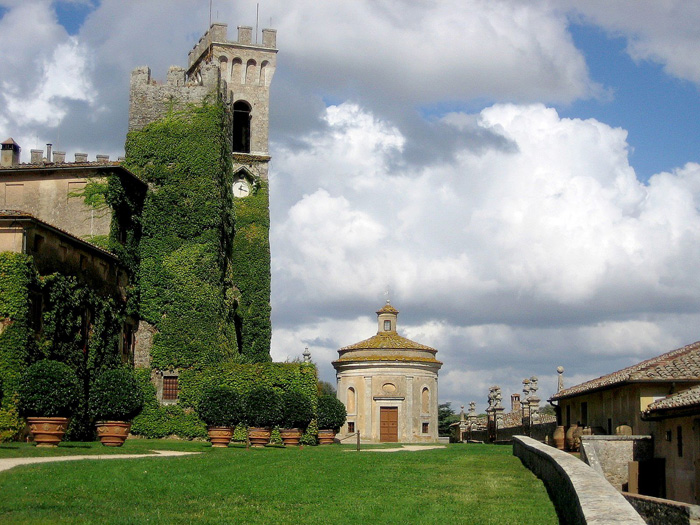 |
||||
Castello di Celsa, chapel
|
||||
Podere Santa Pia, a casa vacanze in the Tuscan Maremma is situated on the outskirts of Castiglioncello Bandini and dominates one of the most beautiful setting that nature can offer: the Tuscan countryside. Podere Santa Pia offers the quiet tranquility of a private retreat, with numerous attractions and gorgeous small hillside villages, natural reserves and beautiful beaches only a short drive away. Holiday homes in the Tuscan Maremma | Holiday home Podere Santa Pia
|
||||
|
||||
 |
 |
 |
||
| Monteriggioni | Sentiero principale della Montagnola senese: Monteriggioni - Ponte della Pia
|
Le mura di Monteriggioni
|
||
 |
 |
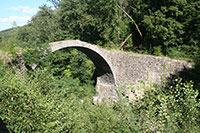 Il Ponte della Pia |
||
San Lorenzo in Colle Ciupi
|
La chiesa di San Giovanni Battista a Molli, Sovicille
|
|
||
La montagnola senese extends in the districts of Siena, Monteriggioni, Sovicille and Casole d'Elsa, but for the most part it is located in the district of Sovicille. Sovicille - Pieve a Molli - Montarrenti - Ponte della Pia | 13 km Trekking in Toscana | Anello Monteriggioni | Monteriggioni – Badia a Isola – Castel Petraia – Monte Maggio Trekking in Toscana | CAI Sentiero n° 100 | Monteriggioni – Ponte della Pia
Itineraries CAI della Montagnola Senese |
||||
Sentieri CAI della Montagnola Senese
|
||||
Walking in the Montagnola senese| Itineraries gpx
|
||||
 |
 |
 |
||
Trekking in the Montagnola Senese
|
CAI 100, Eremo di Santa Lucia (Rosia) | Ponte della Pia – Monteriggioni | ||
Maps: Edizioni Multigraphic Walking Maps of Central Italy 509, Montagnola Senese & Bosco di Lecceto, 1:25,000. |
||||

